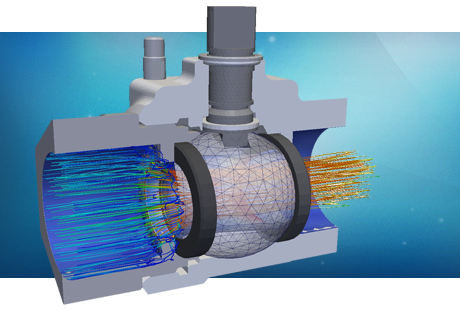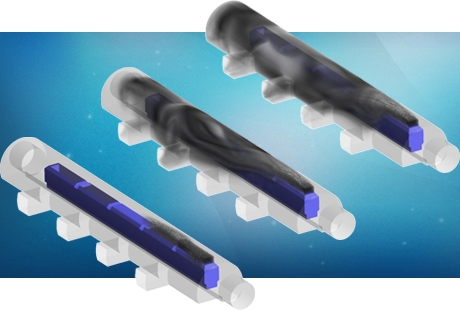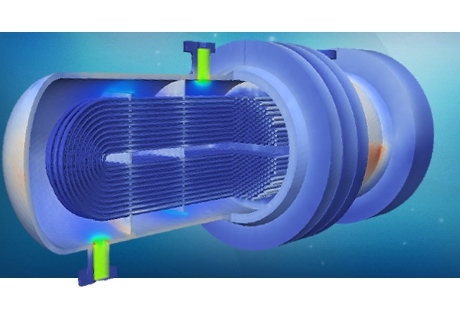Waste to energy processes
Providing sustainable energy for a growing demand is one of the most complex challenges for both developed and developing countries. Current fossil fuels model has proven unreliable and largely dependent on geopolitics and speculation.
 New technologies are developed to try and mitigate countries’ dependency on foreign energy sources while reducing the carbon footprint. Undoubtedly, one of these solutions is to reuse some of the waste we produce to extract useful energy from it.
New technologies are developed to try and mitigate countries’ dependency on foreign energy sources while reducing the carbon footprint. Undoubtedly, one of these solutions is to reuse some of the waste we produce to extract useful energy from it.
PRE Technologies have helped both operators (energy conversion) and system designers optimise their products and processes with the help of advanced computational techniques. The combined use of finite element analysis (FEA) and computational fluid dynamics (CFD) has proven to be an excellent tool for concept validation and process design development. The use of chemical kinetics models in combination with multi-phase fluid modelling can accurately predict your system’s yield at a fraction of the cost and time of the development of a pilot plant.
Waste sources
Waste is available from a variety of sources. The source of waste can determine the details of the processes used to extract energy and their efficiency. All of them however, use similar technology to extract energy. A correct waste physical characterisation is paramount to the accuracy of the computational modelling.
Biomass can be either the direct or a secondary output of agricultural processes. Its organic content can be used for direct energy generation or for the production of biofuels. Similarly, municipal solid waste (MSW) can be converted into refuse-derived fuel (RDF) for use in classical combustion applications or to obtain syngas. The processes by which this product gas is obtained can be several.
Industrial waste can constitute a valuable source of organic material or low grade heat which can be recovered by a variety of thermal devices. Furthermore, a growing interest in the recycling of metallic waste has sparked the development of urban mining techniques.
Energy conversion
PRE Technologies have ongoing collaborations with developers of waste-to-energy technology and assisted their clients on the design and optimisation of all the stages of the process. Computational fluid dynamics (CFD) techniques have been used to model the thermal distribution of gas heaters or heat exchangers, solid particle transportation in mechanically complex reactors and kinetics of species conversion using detailed mechanisms. Collaborations included assisting the design process from concept to realisation, addressing practical design and fatigue life challenges using thermal and mechanical finite element analyses (FEA).

Incineration (see incineration test case here) is a typical combustion process where organic materials are burnt to produce energy. It is the most common waste-to-energy process and is typically strictly regulated in terms of emissions.
Gasification occurs at high temperatures and in a reduced oxygen environment. This reduces the amount of pollutants in comparison with incineration. It produces syngas from organic matter and is often enhanced by the addition of steam to increase the efficiency of the process.
Pyrolysis relies on thermal energy in the absence of oxygen to decompose organic compounds into tars, bio-oils and syngas. It can be combined with gasification processes modify the feedstock for optimal energy conversion.

Similarly to gasification, plasma-arc gasification produces syngas. Significantly higher temperatures are achieved by the use of a plasma torch.
All of these processes share a common framework: waste is collected and frequently pre-treated (screening, shredding, drying, etc.). It then goes through a thermal process (i.e. burnt, pyrolised or gasified) where heat is either extracted directly or indirectly via product gas production and combustion. The extracted heat is then used to produce energy via boilers and steam turbines. Cogeneration of heat and power is also a feature of many of these processes.
There can be significant mechanical complexity in the design of the reactors and the auxiliary equipment required to effectively use the energy produced from the process. Boilers, heat exchangers, gas burners and heat recovery steam generators (HRSG) and post combustion chambers have all been successfully analysed using bespoke CFD techniques to optimise the flow and maximise energy conversion. Fluidised bed reactors have been also subject to optimisation using a combination of multi-phase CFD analysis and complex combustion kinetics models.

Some alternative waste-to-energy plants use biological, rather than thermal, processes. Anaerobic digestion uses microorganisms to promote a set of reactions in the absence of oxygen to produce useful fuels for energy production. The process can be a batch or continuous one. Fermentation is a similar process which can produce hydrogen or methane. These processes are frequently preceded by mechanical-biological treatment (MBT) to optimise the chemical process by physically manipulating the feedstock by magnetic elements such as eddy current separators or mechanical ones such as filters and shredders.
PRE Technologies have developed computational tools for the analysis of several mechanical processing and mixing technologies. CFD simulation for the optimisation of reactor geometry, impeller and screw conveyor modelling and the evaluation of mechanical response for structural and power requirements are all examples of past projects. Our expertise extends to mechanical handling equipment such as conveyors, rotating machinery (e.g. dryers, kilns, trommels), separators and vibrating equipment.
Recycling

Some of the above technologies can be used for the recycling and extraction of valuable materials from waste. In particular plasma arc gasification can achieve the high temperatures required for smelting and recovery of precious metals. PRE Technologies have developed a range of computational techniques to optimise the urban mining process, as well as assessing its safe operation. These include the simulation of flow and thermal dynamics in multiphase reactors for operational and accidental cases. Coupled mechanical and fluid simulations can be performed to determine the thermal behaviour of these systems. This can be focused on optimisation as well as the evaluation of structural integrity in events such as blast wave resulting from explosive events.
The recovery of low grade heat from industrial processes represents an opportunity which can be capitalised by the selection of the right thermodynamic process. Heat exchangers and heat pumps are all useful tools and the use of CFD analysis is an effective tool for the maximisation of efficiency for heat recovery.
For more information on other services for waste to energy, please contact us here.
Our services for this sector
Pyrolysis and gasification
- Chemical kinetics CFD modelling for species conversion prediction in gasification and pyrolysis
- Solid particle transportation modelling (kilns, retorts, conveyors)
- Performance prediction for different feedstocks: RDF, coal, industrial waste
- Product gas treatment modelling: Filtering, compression, solid separation
- Gas heaters and flue gas system optimisation using CFD analysis
- Concept assessment and system optimisation: Heating, feedstock conveying, gas treatment, chemical modelling.
Anaerobic digestion
- CFD fluid flow calculations for anaerobic digestors
- CFD-based agitation optimisation: Impellers and baffles configuration
- Chemical reaction prediction with coupled thermal and chemical CFD models
- Performance assessment for different operational conditions and feedstocks
- Safety assessments: Blast and fluid diffusion simulation
Incineration
- CFD advanced combustion models for thermal performance
- Thermal-stress analysis for mechanical elements: Combustion chamber structure, boiler, tubesheets, etc.
- Thermal CFD analysis of heat recovery systems
- Particulate filtering and flue gas treatment analysis using CFD







